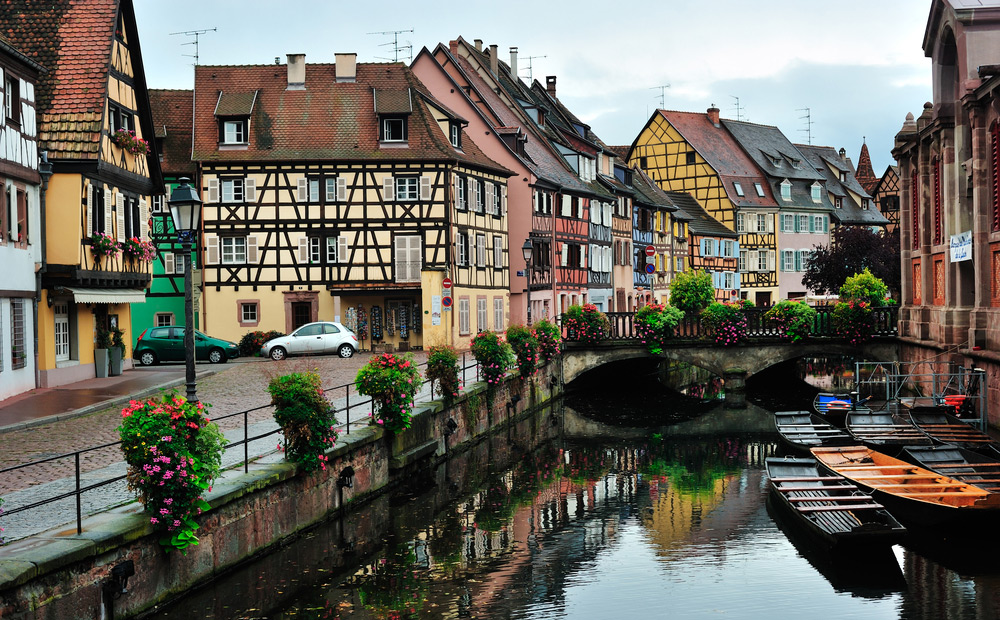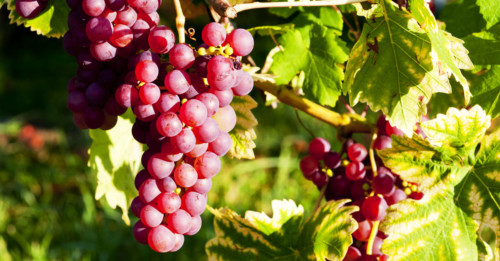Gewürztraminer is one of the few white grapes recognizable from sight alone. Much like Pinot Gris/Grigio, its skin is pink, not pale green. This pigment translates to a medium or sometimes deep golden color in the glass. If you get tripped up by its appearance in a blind tasting, you’ll have another shot at identifying Gewürztraminer by its undeniable lychee and rose aromas. But before going too far into what makes Gewürztraminer so unique, we need to be able to pronounce the grape properly: “ga-VERTZ-trah-mee-ner.”
Gewürztraminer in 60 Seconds
- Gewürztraminer hails from Alsace, located on the border between Germany and France.
- Gewürztraminer is one of Alsace’s four noble varieties and is often made into varietal wines.
- Sweetness levels can vary from dry to sweet. Most Gewürztraminer wine is off-dry with just a touch of sweetness.
- Alsacian Gewürztraminer accounts for one-quarter of Gewürztraminer grown around the world. It’s also found in Germany, Australia, and the United States.
The Origins of Gewürztraminer
In German, Gewürztraminer translates to “spice traminer.” Traminer is another name for Savagnin (or Sauvignon Blanc), which Gewürztraminer is genetically linked to. The grape originated in Germany and does well in cool-climates. This trait allowed it to be planted by producers on the foothills of the Alps in countries such as Austria, Italy, Hungary, and France.

The reference to spice is considered to be a synonym for its aromatic qualities. Gewürztraminer is famed for its poignant aromas of lychee, sweet baking spices, and floral rose notes.
What Gewürztraminer Tastes Like
Most Gewürztraminer is off-dry or semi-dry. In some versions, the sweetness comes from higher levels of residual sugar but that’s not the case with all Gewürztraminer wines. The grape’s heightened aromatics and low acidity mean even dry expressions can taste sweeter than they actually are. Most versions have a medium to full body and medium alcohol, though it’s common to see lower ABV levels in wines with higher residual sugar.
Gewürztraminer’s Nobility
Gewürztraminer is one of four “noble” grape varieties grown in Alsace. Along with Riesling, Pinot Gris, and Muscat, it is the only variety that can be used for grand cru, Vendanges Tardives (VT), and Sélection de Graines Nobles (SGN) wines. Here’s a quick breakdown of what those terms mean:
Grand cru: produced from a single noble grape variety, with limited yields, from one of 50 designated vineyards.
Vendanges Tardives: Late-harvest wines made from a single noble grape variety that must have a specific minimum sugar ripeness at harvest (257g/L).
Sélection de Graines Nobles: Sweet wines that must be made from botrytis-affected grapes and reach a specific minimum sugar ripeness at harvest (306 g/L).
Foods To Pair With Gewürztraminer
Gewürztraminer’s range of sweetness levels makes it a good pairing for a variety of foods. Drier styles, or versions with a touch of sweetness, are perfect to tone down the heat of spicy food. Explore dishes from Morocco (like tagine) or Latin America (try ceviche) for an explosive yet balanced pairing.
For dessert-style Gewürztraminer wine, serve with confections that include cinnamon, honey, dried nuts or dried fruit. Those flavors will be mirrored in the wine, making for the perfect pairing.
